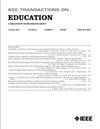移动学习应用可用性综合测量工具
IF 2.1
2区 工程技术
Q2 EDUCATION, SCIENTIFIC DISCIPLINES
引用次数: 0
摘要
贡献:本文介绍了用于评估移动学习应用程序(CECAM)可用性的调查问卷的制作过程。该问卷包括评估用户界面可用性和教学可用性的具体问题。背景:如今,移动应用程序正在迅速发展,并被教育机构普遍用于支持学习和教学过程。但可能存在的可用性缺陷会降低学习活动的效用和学生的学习积极性。因此,开发人员需要精心策划和设计,并对应用程序进行可用性评估。研究问题:如何开发一种结合技术和教学方面的工具来评估移动学习应用程序的可用性?如何确定所开发工具的质量?研究方法:制作了一份结构化问卷,作为评估和设计移动学习应用程序的测量工具。采用不同的统计技术,包括信度和效度评估,来评价工具的质量,并通过校准 CECAM 调查来确定。调查结果:在对问卷进行有效性分析后,得到了一个包含 56 个项目的量表,其阿尔法信度系数为 0.911(一个优秀的测量量表)。该量表可用于教师设计或评估移动学习应用程序,提高其可用性,改善学生的学习体验。本文章由计算机程序翻译,如有差异,请以英文原文为准。
A Comprehensive Usability Measurement Tool for m-Learning Applications
Contribution: This article describes the process used to create a questionnaire to evaluate the usability of mobile learning applications (CECAM). The questionnaire includes specific questions to assess user interface usability and pedagogical usability. Background: Nowadays, mobile applications are expanding rapidly and are commonly used in educational institutions to support the learning and teaching process. But the possible deficient usability could decrease the utility of learning activities and the student’s motivation. Therefore, careful planning and design by the developer are required, along with a usability evaluation of the applications. Research Questions: How could an instrument be developed to evaluate the usability of m-learning applications that combine technical and pedagogical aspects? How can the quality of the developed instrument be determined? Methodology: A structured questionnaire was created like a measuring tool to evaluate and design m-learning applications. Different statistical techniques, including reliability and validity assessments, were employed to evaluate the quality of the instrument, which is determined through the calibration of the CECAM survey. Findings: After the validity analysis of the questionnaire, a scale with 56 items was obtained, with an alpha reliability coefficient of 0.911 (an excellent measuring scale). It pretends to be used by teachers to design or evaluate m-learning applications, improve their usability, and enhance the students’ learning experience.
求助全文
通过发布文献求助,成功后即可免费获取论文全文。
去求助
来源期刊

IEEE Transactions on Education
工程技术-工程:电子与电气
CiteScore
5.80
自引率
7.70%
发文量
90
审稿时长
1 months
期刊介绍:
The IEEE Transactions on Education (ToE) publishes significant and original scholarly contributions to education in electrical and electronics engineering, computer engineering, computer science, and other fields within the scope of interest of IEEE. Contributions must address discovery, integration, and/or application of knowledge in education in these fields. Articles must support contributions and assertions with compelling evidence and provide explicit, transparent descriptions of the processes through which the evidence is collected, analyzed, and interpreted. While characteristics of compelling evidence cannot be described to address every conceivable situation, generally assessment of the work being reported must go beyond student self-report and attitudinal data.
 求助内容:
求助内容: 应助结果提醒方式:
应助结果提醒方式:


